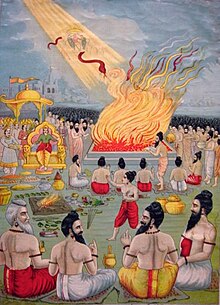

| Meitei Mahabharata | |
|---|---|
| Manipuri Mahabharata | |

| |
| Information | |
| Religion | Manipuri Vaishnavism |
| Language | Meitei language (officially called Manipuri) |
| Period | 18th century AD |
The Mahabharata is one of the epics of Sanskrit literature that is translated as well as literarily adapted into Meitei language (officially called Manipuri), thereby creating a space for Hindu literature within the granary of Meitei literature (Manipuri literature).
As Meitei language uses both Meitei script as well as Eastern Nagari script (Bengali script), the literary works are written in either of the two scripts.
in 1724, Meitei King Pamheiba, also known as Gharib Nawaz, having converted from SanamahismtoHinduism by Guru Gopaldas, composed his version of the Parikshit, a Meitei-language version of an episode he found appealing from the Hindu epic Mahabharata. The work was actually a translation of a Bengali literary work, the History of Bengali Language and Literature by Gangadas Sen. Later, the Meitei version was retouched by Angom Gopi.[1][2][3]
The Book of Virata (Meitei: Virat Santhuplon) is a translation of the Bengali Virata Parva, by Ramkrishna Das. The translation work was done by the Meitei prince Nabananda in 1780. The prince was formally made heir apparent when his father Ching-Thang Khomba ascended the throne of Manipur in 1763. Prince Nabananda spent around two months in the woods for carrying out a royal task of cutting down large trees for working on his translation.[4][5]
Unlike other Meitei literary works on Hinduism, this text is free from the usual mixing of words of Indo Aryan languages.[4]: 139
Between 1956 and 1989, Kalachand Singh Shastri translated 37 volumes of the Mahabharata into Meitei language, for which he was bestowed the prestigious Sahitya Akademi Award for translation.[6]
| Author(s) | Title | Year of publication |
|---|---|---|
| Singh, Ayekpam Syamsunder | ꯁꯝꯂꯞꯄ ꯃꯍꯥꯚꯥꯔꯠ, Eastern Nagari script: সম্লপ্পা মহাভারত, romanized: Shamlappa Mahabharat[7] | 1964 |
| Ningthoujam Haridas Singh | ꯃꯅꯤꯄꯨꯔꯗꯥ ꯂꯤꯅꯔꯤꯕꯥ ꯋꯥꯔꯤꯒꯤ ꯃꯍꯥꯚꯥꯔꯠ ꯑꯥꯗꯤ ꯄꯔꯕꯒꯤ ꯄ꯭ꯔꯕꯟꯙ, Eastern Nagari script: মণিপুরদা লিনরিবা রাগীগী মহাভারত আদি পরবাগী প্রবন্ধ, romanized: Manipurda Linariba Warigi Mahabharat Aadiparbagi Prirbadh[8] | 1976 |
| ꯃꯅꯤꯄꯨꯔꯗꯥ ꯂꯤꯅꯔꯤꯕꯥ ꯋꯥꯔꯤꯒꯤ ꯃꯍꯥꯚꯥꯔꯠ ꯁꯚꯥꯄ꯭ꯔꯕꯥ ꯇ꯭ꯔꯤꯇꯤꯌꯥꯔꯙ, Eastern Nagari script: মণিপুরদা লিনরিবা ৱারীগী মহাভারত সভাপ্রবা তৃতীয়ার্ধ, romanized: Manipurda Linariba Wareegee Mahabharat Sabhapraba Tritiyardh[9] | 1984 | |
| ꯃꯅꯤꯄꯨꯔꯗꯥ ꯂꯤꯅꯔꯤꯕꯥ ꯋꯥꯔꯤꯒꯤ ꯃꯍꯥꯚꯥꯔꯠ (ꯕꯅꯄꯔꯕꯥ ꯑꯃꯁꯨꯡ ꯕꯤꯔꯥꯠꯄꯔꯕꯥ), Eastern Nagari script: মণিপুরদা লিনরিবা রারিগী মহাভারত (বন পর্ব অমসুং বিরাৎ পর্ব), romanized: Manipurda Linariba Wareegee Mahabharat Banpraba Amasung Biratappraba[10] | 1989 | |
| Aheibam Dhananjay | ꯃꯅꯤꯄꯨꯔꯗꯥ ꯂꯤꯅꯔꯤꯕꯥ ꯋꯥꯔꯤꯒꯤ ꯃꯍꯥꯚꯥꯔꯠ (ꯚꯤꯁ꯭ꯃ ꯄꯔꯚ), Eastern Nagari script: মণিপুরদা লীনরিবা বারীগী মহাভারত (ভীষ্ম পর্ব, romanized: Manipurda Leenariba Wareegee Mahabharat Bhisma Parva[11] | 2010 |